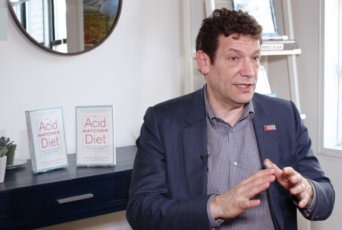When Gabriella Campagna, a New York City-based acress, was diagnosed with Hashimoto’s, her doctor prescribed her Synthroid medication, a common synthetic thyroid hormone, and sent her on her way. Soon after, her mental health began completely breaking down, but nobody thought it was related to her Hashimoto’s thyroiditis treatment. Read on to learn how extreme side effects of Synthroid sent Campagna to a psychiatric hospital and how she eventually found more natural remedies for hypothyroidism.
You can also listen to an audio version of this interview on The WellBe Podcast.
Getting a Diagnosis of Hashimoto’s Thyroiditis
Campagna’s health issues first showed up in her early 20’s, when she began experiencing fatigue, joint pain, and thinning hair, as well as constantly feeling cold. She also started to feel depressed, something she’d never struggled with before. But she’d just graduated from college and was struggling to get her dance career off the ground, so she chalked it up to just being in a low moment in her life.
She brought up her symptoms to her doctors, but none of them seemed to think it was much. Then, she accompanied her mom to the Pritikin Center, a sort of wellness spa, where she got various tests done. The results showed that her TSH (thyroid stimulating hormone) was 10.5, far outside the conventional healthcare system’s normal range of 0.5 to 5.0. She also had elevated levels of thyroid antibodies, indicating an autoimmune condition. Those two results together indicated that she had Hashimoto’s thyroiditis.
Hashimoto’s thyroiditis is the most common thyroid disorder in the U.S., affecting 14 million people. It’s a type of hypothyroidism that is caused by an autoimmune disorder where the thyroid gland can’t properly make thyroid hormones, leading to a gradual decline in function. Hashimoto’s thyroiditis treatment almost always involves a prescription for Synthroid medication (a synthetic thyroid hormone). Synthroid is the most-prescribed brand-name drug in the U.S. and the most commonly prescribed drug for any sort of thyroid issue, with around 123 million prescriptions handed out annually.
Trying Conventional Treatment for Hashimoto’s
After she got her diagnosis, Campagna got an appointment with a doctor considered one of the best in New York City. “I went in and for about 20 minutes, he barely looked at me. He looked at my numbers and said, ‘Okay, well, you should be on 50 mg of Synthroid,” she remembers. “He wrote my prescription and I went home.”
The Synthroid medication initially helped her feel better — her energy was back, and the other symptoms began to fade as well. But soon, she began to experience anxiety, heart palpitations, and manic behavior. Campagna felt much better, so she didn’t particularly mind the manic feeling, but her friends and family were concerned because she didn’t seem to be herself.
Her mother intuitively thought that the drug was the cause of Campagna’s shift in mental state, but multiple doctors told her it wasn’t related, that this type of change was not one of the side effects of Synthroid. Eventually Campagna went to a doctor who suggested that they could lower the dose of Synthroid medication from 50 to 25 mg, with the caveat that she was already on such a low dose it was unlikely to make any difference.
Immediately after her dosage was lowered, Campagna’s mental state plummeted. “I just went into this really low swing of major depression for about nine months,” she says. “I didn’t have a period that whole time. I gained 30 pounds. I never wanted to see friends. I didn’t see the point in anything. I quit my job.”
Still, her TSH levels were fine, so doctors kept telling her that there was nothing wrong with her thyroid, that she had a mental issue. “They kept saying to me, ‘Look, this has nothing to do with the thyroid. You’re probably bipolar. You need to see a psychiatrist,’” Campagna says.
Eventually she hit such a low point that she began to believe the doctors were right, that maybe she did have depression or bipolar disorder. She saw a psychiatrist who offered to prescribe her antidepressants, and she was tempted — nothing else she tried seemed to be working — but her parents pushed back. Her mother took her to Colombia, where she is from, to visit an endocrinologist there and see if she could get a new perspective. When Campagna told the doctor her symptoms, the doctor said it had to be connected to her thyroid issues, and recommended that she increase her dosage of Synthroid once again. She left Colombia with a prescription for 75 mg of Synthroid medication.
Within three weeks, after nine months of depression, Campagna had symptoms of full-on mania. “It was scary. I was aware it was scary,” she says. “You’re running on what feels like this incredible amount of energy. Your brain is moving really fast but there’s just no filter, and I wasn’t sleeping.” This went on for four months.
Bipolar Disorder — or Side Effects of Synthroid?
At this point, Campagna had seen seven endocrinologists and two psychiatrists among many other practitioners. The only one who had provided any benefit was an acupuncturist, who helped Campagna get her period back after just two sessions. “This should’ve already been a red flag — I need to move in [the direction of integrative medicine.] I knew that but I was so afraid to stop taking the Synthroid because of what had happened when they lowered the dose,” she says.
Campagna had been thoroughly convinced that she needed the Synthroid medication because of her thyroid condition. What she didn’t know was that it was completely wrong for her body, leading her to one of the most extreme (and also extremely rare) side effects of Synthroid: the drug was causing thyroid toxicity, which creates massive swings in her thyroid function. She was rapidly going from having a hyperactive thyroid to an underactive one in a way that manifests very similarly to bipolar disorder.
But now knowing this, and seeing how unstable her mental health had become, Campagna’s parents reluctantly sent her away to a psychiatric hospital in Connecticut. The doctors in there had no knowledge of her thyroid condition and weren’t communicating at all with her previous doctors. She knew that she was manic but she also knew that there was an underlying physical root cause — she didn’t have a mental illness.
After the hospital in Connecticut didn’t help, she was sent to a rehab center in Malibu. Her parents intended for it to be a place where she could rest, eat well, and undergo therapy — without drug intervention — but within her first week, staff told her she was being so disruptive in group therapy she’d have to take an antipsychotic to stay there. So she did. That night, she woke up having convulsive attacks so strong she thought she was in an earthquake.
The head of the rehab center told her parents that she needed to be in a high-security mental hospital, that it would be irresponsible not to send her. If they’d listened, Campagna believes she would have been put on massive sedatives to quell the mania, and likely needed to take steroids for the rest of her life. Thankfully, her parents still believed that there was something else going on, and they were determined to get to the bottom of it.
Finding Natural Remedies for Hypothyroidism
After leaving Malibu and returning to New York, the family ended up finding Dr. Michael E. Doyle, an integrative doctor in Connecticut. Unlike the doctors Campagna had seen before, he was open to the idea that her case might be different than those he’d seen before. “He’s open-minded,” she says. “He listens to patients’ symptoms and understands that it’s not just a number, that you can’t just prescribe a drug that might mask the situation.”
She told Dr. Doyle her story, and he immediately knew that everything she’d gone through was related to her thyroid and side effects of Synthroid. He also told her that similar things had happened to other people — about 0.1% of those who take Synthroid, to be precise. Because this instance of this toxic reaction is so rare, none of Campagna’s previous doctors had even considered it.
“I had fear put into me by my doctors and by my own experience that I needed Synthroid to survive,” she says. “In fact, it was what was making me sick.”
Dr. Doyle prescribed a new medication, called Armour, which is among the more natural remedies for hypothyroidism. Armour is made from desiccated animal thyroid glands, and it’s bioidentical to the human thyroid hormone that it’s replacing, which means there are little to no side effects. Synthroid medication, on the other hand, is not identical to what the human body creates — it acts in the same manner, but it’s not the same substance, so there are many long- and short-term side effects of Synthroid even for those who don’t have a toxic reaction.
Within a few weeks, Campagna felt immeasurably better. “I felt like finally, I was back. My head was back in my body in the way I had known it to be,” she says.
Today, Campagna finally feels like she’s in a stable place. Her Hashimoto’s thyroiditis treatment consists of the Armour in combination with other conscious lifestyle choices around diet, exercise, acupuncture, and complementary therapies like acupuncture. She emphasizes that there’s no one-size-fits-all solution for autoimmune conditions like Hashimoto’s and that it’s essential to work with a practitioner who looks at all of your symptoms as a whole and focuses on root-cause treatment. “You have to find someone who wants to look at you as a complex being,” she says. “Then, ultimately, you have to heal yourself.”
Watch the full interview with Gabrielle Campagna to hear her full story and what she learned from the experience, including how pharmaceutical kickbacks influence thyroid treatment, the serendipitous way she found the doctor who changed her life, how seasonal changes impact her dosage of Armour, what buying marijuana on Venice Beach had to do with her recovery, and much more.
You can also listen to her full interview on the podcast.
Have you ever had an extreme reaction to a common medication? Share your story in the comments below!
Citations
- Biondi, B. The Normal TSH Reference Range: What Has Changed in the Last Decade? The Journal of Clinical Endocrinology & Metabolism, Volume 98, Issue 9, 1 September 2013, Pages 3584–3587
- Garber JR, Cobin RH, Garib H, et al. Clinical practice guidelines for hypothyroidism in adults: cosponsored by the American Association of Clinical Endocrinologists and the American Thyroid Association. Endocrine Practice. 2012;18(6):988–1028.
- Hoang TD et al. Desiccated thyroid extract compared with levothyroxine in the treatment of hypothyroidism: A randomized, double-blind, crossover study. J Clin Endo- crinol Metab 2013;98:1982-90. Epub March 28, 2013.
The recovery story above is anecdotal and specific to this particular individual. Please note that this is not medical advice and that not all treatments and approaches mentioned will work for everyone.








This is me!!! I am 47 and was diagnosed bipolar at 13. Meds only made everything worse. Fast forward to today, age 47. I just wasted the last 15 months taking no thyroid 180mg and 120 mg liothyronine. The first month on liothyronine was heaven. Actually I just felt manic, but after the years of brain fog, aches and pains it was a welcomed relief. Then the burn out happened a d my doc increased it to 100mg. OMG…worst month of my life. It was a bipolar rollercoaster!! My doc did not listen to me. Kept repeating “its the adjustment phase” 8 months of adjustments and I finally had enough. I felt like I was on the verge of a stroke and could not make it up or down a flight of stairs without loosing my breath. This was a functional medicine doctor too. Once I complained, he to me to stop both meds cold turkey. The last week has been hell. I am shocked I made it thru. Suicide was on my mind more than I would like to admit.
I do not know how to change this part of our medical culture, but it must stop. Do No harm….
Hi Tara, so sorry to hear about all that you have been through, and glad that you can relate to our content! If you haven’t already, be sure to subscribe to our weekly newsletter here! Xx Adrienne & Team WellBe
I can relate to this roller coaster of changing dosages trying to alleviate symptoms. Depression, mania and back and forth in between. I am awaiting my NDT in the mail. Hope it helps because I feel like Synthroid only gives me brief windows of feeling good before I get mentally unstable again. Ugh. There has to be a better way.
Hi Erin! We are so sorry to hear about your symptoms, and we completely agree – there does have to be a better way! Hoping you find some relief and sending healing vibes! Xx Adrienne and Team WellBe
Happened to me too. Luckily Dr started me on 25mcg, lowest dose available, so for me it was a wonderful surge of energy, feeling positive, strong and healthy. I loved it and happily thought I was cured. The feeling only lasted about 10 days. Then I crashed, reverted to my previous unhealthy state. Oh well. Things have gradually improved over the years but not anywhere near those first 10 days.
My endocrinologist suggested I switch from Armor to Synthroid because Armor is on the Beers list of meds than can cause adverse reactions in ppl over 65. I had been on Synthroid 30 yrs ago when I was first diagnosed with Hashimoto’s. I know I wasn’t doing well on it and my doctor switched me to Armor, but couldn’t recall specifics, so I reluctantly agreed. Within 2 days I was so fatigued that I slept 18 hrs a day. I had extreme brain fog on top of body aches. The pain in my legs was so bad I could only go up or down steps one at a time and used the railing to pull myself up. After getting the mail, I literally collapsed in bed & fell asleep. What’s worse is that even pain medications didn’t relieve the pain. After 2 weeks of living a haze, I switched back to Armor. By that first afternoon I had more energy & the next day I was back to normal. I experienced other side effects but they were minor in comparison.
After 15 years on Synthroid , started having heart palpitations at night. Felt like I had a Tube Train UP MY SPINE!!! My QUACK Endo won’t prescribe me Armour. Still suffering and looking for anyone I can find that will prescribe……